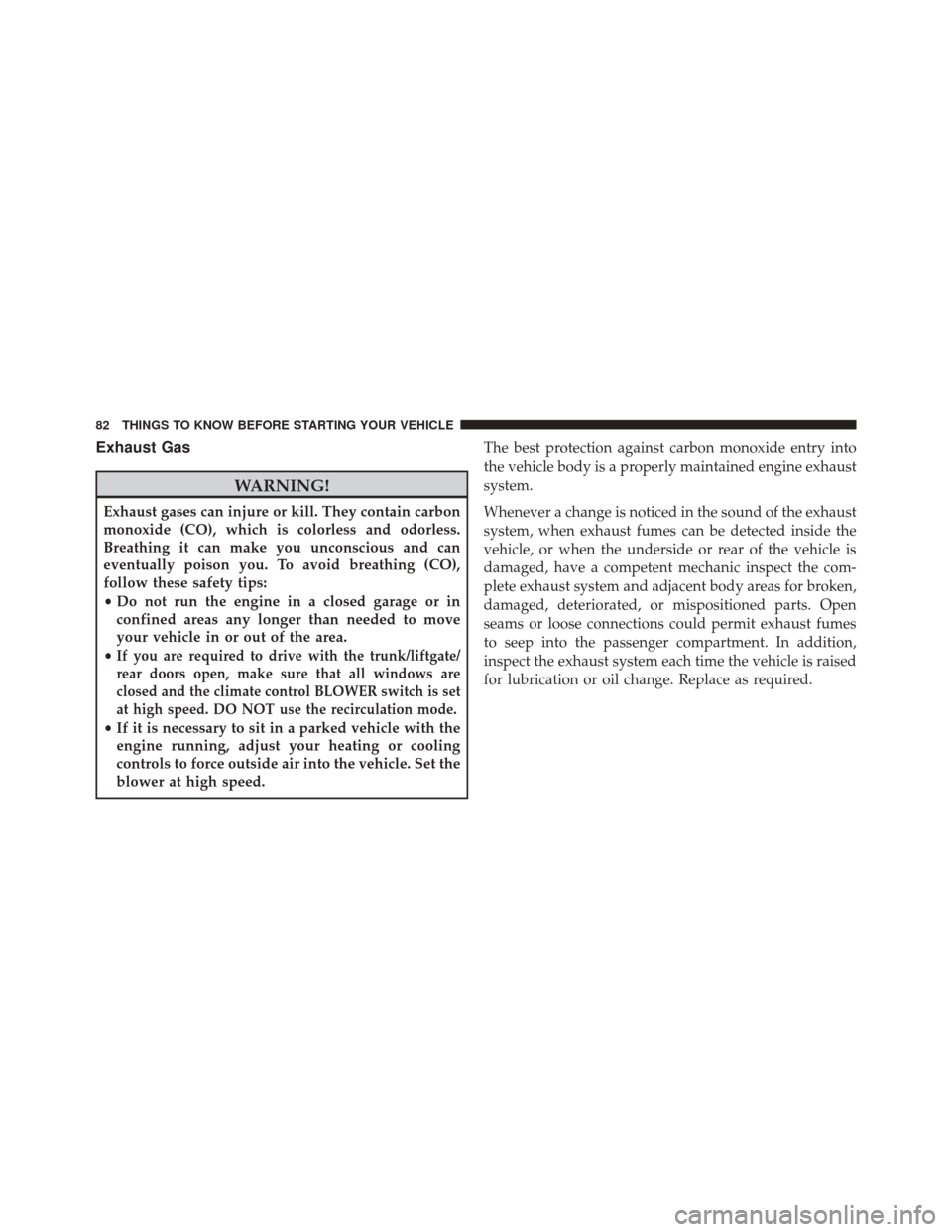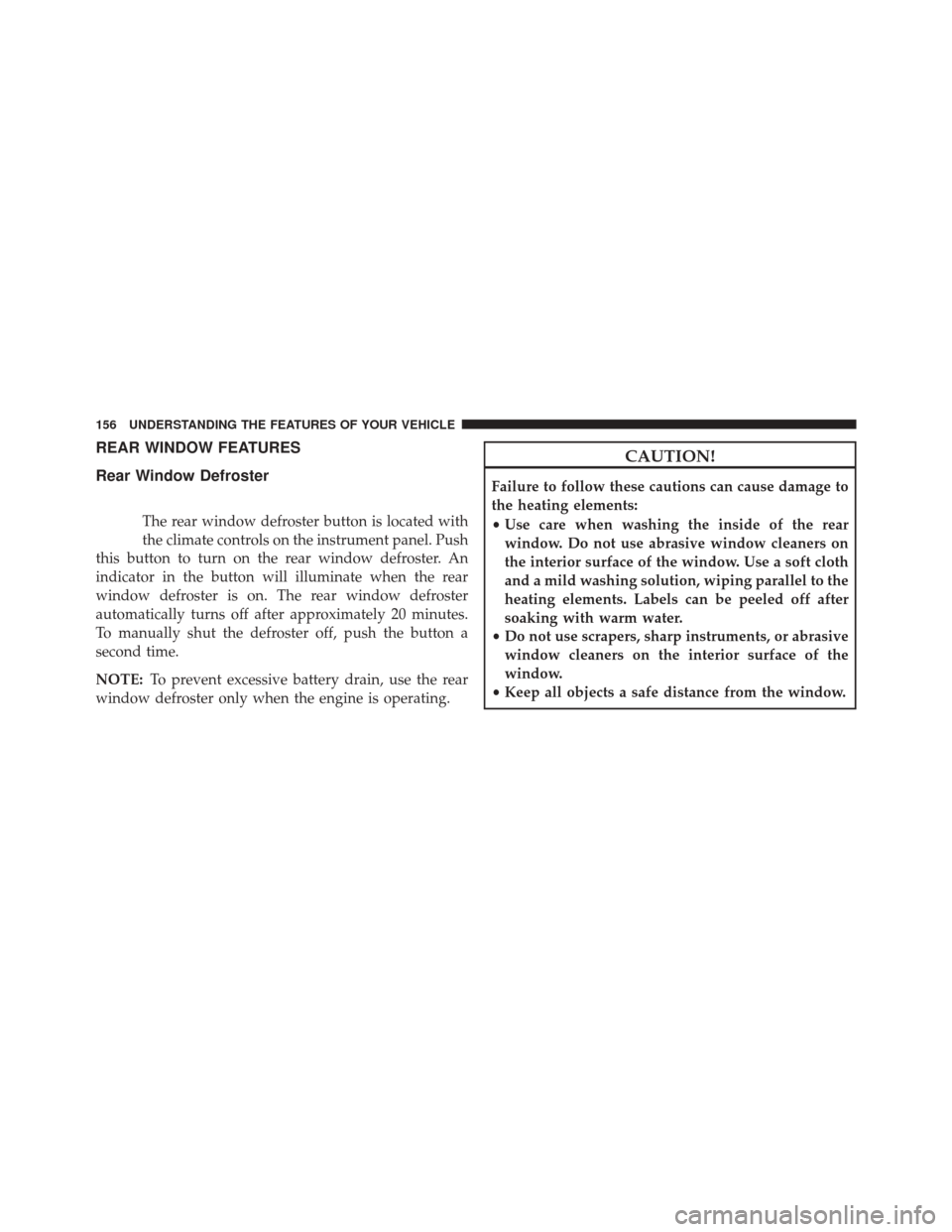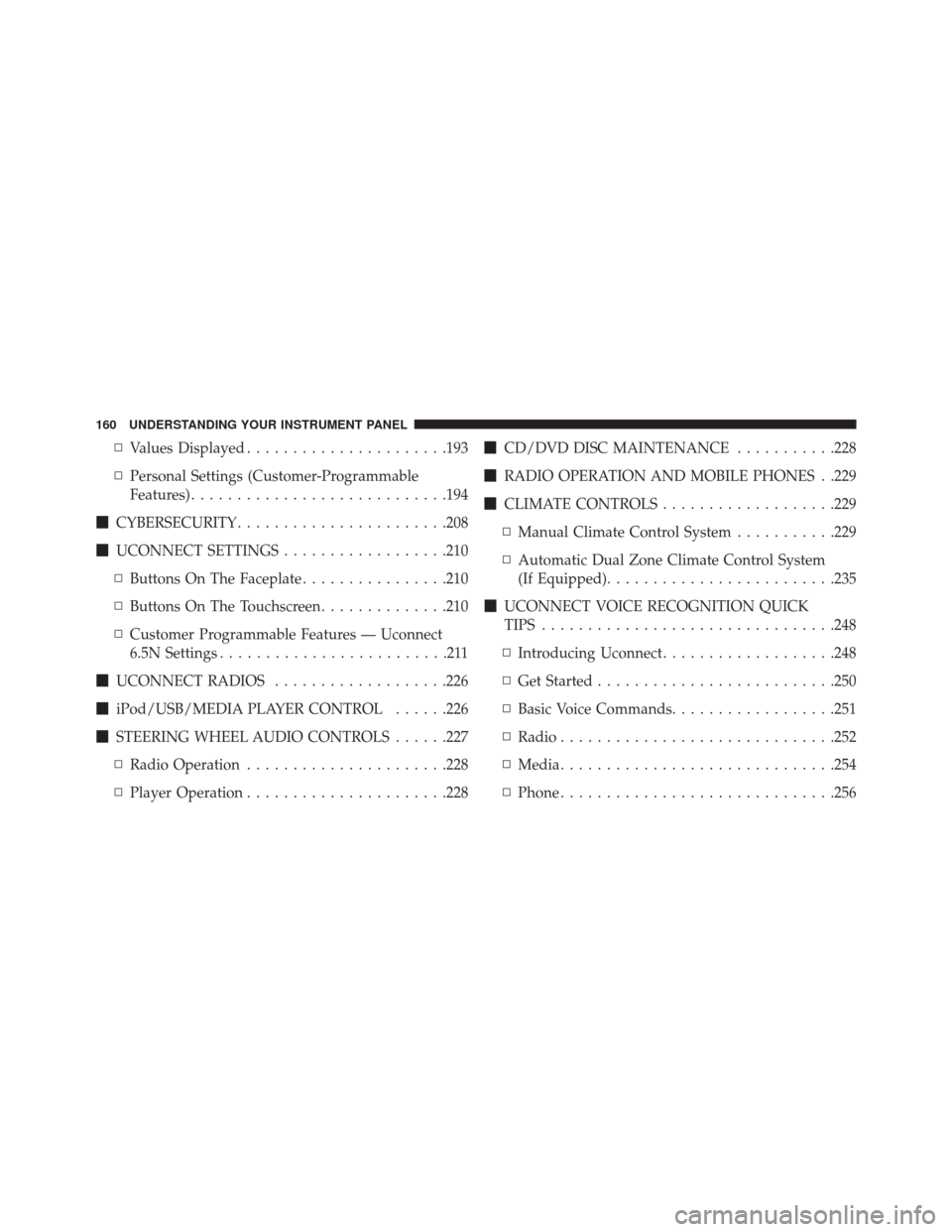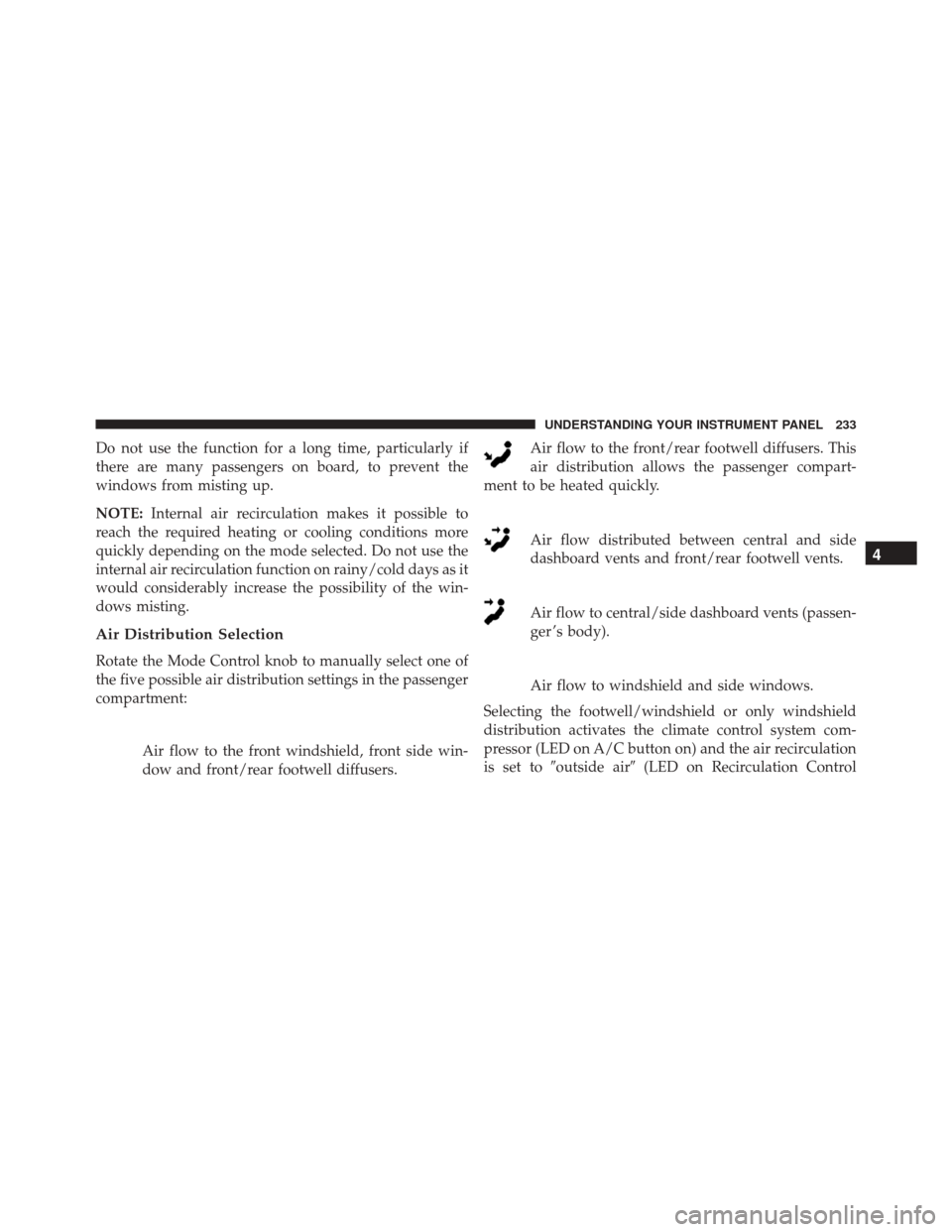Page 31 of 476

open or partially open positions. This is a normal occur-
rence and can be minimized. If the buffeting occurs with
the sunroof open, adjust the sunroof opening to minimize
the buffeting or open any window.
LIFTGATE
To unlock the liftgate, use the Remote Keyless Entry
(RKE) transmitter or activate the central locking button
located on the instrument panel below the radio.
To open the liftgate, push the liftgate electronic release
and pull the liftgate open with one fluid motion.
WARNING!
•Driving with the liftgate open can allow poisonous
exhaust gases into your vehicle. You and your
passengers could be injured by these fumes. Keep
(Continued)
WARNING! (Continued)
the liftgate closed when you are operating the
vehicle.
• If you are required to drive with the liftgate open,
make sure that all windows are closed, and the
climate control blower switch is set at high speed.
Do not use the recirculation mode.
Gas props support the liftgate in the open position.
However, because the gas pressure drops with tempera-
ture, it may be necessary to assist the props when
opening the liftgate in cold weather.
Liftgate Emergency Release
As a security measure, a Liftgate Emergency Release is
built into the liftgate latching mechanism. To access the
Liftgate Emergency Release proceed as follows:
2
THINGS TO KNOW BEFORE STARTING YOUR VEHICLE 29
Page 84 of 476

Exhaust Gas
WARNING!
Exhaust gases can injure or kill. They contain carbon
monoxide (CO), which is colorless and odorless.
Breathing it can make you unconscious and can
eventually poison you. To avoid breathing (CO),
follow these safety tips:
•Do not run the engine in a closed garage or in
confined areas any longer than needed to move
your vehicle in or out of the area.
•
If you are required to drive with the trunk/liftgate/
rear doors open, make sure that all windows are
closed and the climate control BLOWER switch is set
at high speed. DO NOT use the recirculation mode.
• If it is necessary to sit in a parked vehicle with the
engine running, adjust your heating or cooling
controls to force outside air into the vehicle. Set the
blower at high speed. The best protection against carbon monoxide entry into
the vehicle body is a properly maintained engine exhaust
system.
Whenever a change is noticed in the sound of the exhaust
system, when exhaust fumes can be detected inside the
vehicle, or when the underside or rear of the vehicle is
damaged, have a competent mechanic inspect the com-
plete exhaust system and adjacent body areas for broken,
damaged, deteriorated, or mispositioned parts. Open
seams or loose connections could permit exhaust fumes
to seep into the passenger compartment. In addition,
inspect the exhaust system each time the vehicle is raised
for lubrication or oil change. Replace as required.
82 THINGS TO KNOW BEFORE STARTING YOUR VEHICLE
Page 158 of 476

REAR WINDOW FEATURES
Rear Window Defroster
The rear window defroster button is located with
the climate controls on the instrument panel. Push
this button to turn on the rear window defroster. An
indicator in the button will illuminate when the rear
window defroster is on. The rear window defroster
automatically turns off after approximately 20 minutes.
To manually shut the defroster off, push the button a
second time.
NOTE: To prevent excessive battery drain, use the rear
window defroster only when the engine is operating.
CAUTION!
Failure to follow these cautions can cause damage to
the heating elements:
• Use care when washing the inside of the rear
window. Do not use abrasive window cleaners on
the interior surface of the window. Use a soft cloth
and a mild washing solution, wiping parallel to the
heating elements. Labels can be peeled off after
soaking with warm water.
• Do not use scrapers, sharp instruments, or abrasive
window cleaners on the interior surface of the
window.
• Keep all objects a safe distance from the window.
156 UNDERSTANDING THE FEATURES OF YOUR VEHICLE
Page 160 of 476

WARNING!
Cargo must be securely tied before driving your
vehicle. Improperly secured loads can fly off the
vehicle, particularly at high speeds, resulting in per-
sonal injury or property damage. Follow the roof rack
cautions when carrying cargo on your roof rack.
REAR WINDOW FEATURES
Rear Window Defroster
The rear window defroster button is located with
the climate controls on the instrument panel. Push
this button to turn on the rear window defroster. An
indicator in the button will illuminate when the rear win-
dow defroster is on. The rear window defroster automati-
cally turns off after approximately 20 minutes. To manually
shut the defroster off, push the button a second time.
NOTE: To prevent excessive battery drain, use the rear
window defroster only when the engine is operating.
CAUTION!
Failure to follow these cautions can cause damage to
the heating elements:
• Use care when washing the inside of the rear
window. Do not use abrasive window cleaners on
the interior surface of the window. Use a soft cloth
and a mild washing solution, wiping parallel to the
heating elements. Labels can be peeled off after
soaking with warm water.
• Do not use scrapers, sharp instruments, or abrasive
window cleaners on the interior surface of the
window.
• Keep all objects a safe distance from the window.
158 UNDERSTANDING THE FEATURES OF YOUR VEHICLE
Page 162 of 476

▫Values Displayed ..................... .193
▫ Personal Settings (Customer-Programmable
Features) ........................... .194
� CYBERSECURITY ...................... .208
� UCONNECT SETTINGS ..................210
▫ Buttons On The Faceplate ................210
▫ Buttons On The Touchscreen ..............210
▫ Customer Programmable Features — Uconnect
6.5N Settings .........................211
� UCONNECT RADIOS ...................226
� iPod/USB/MEDIA PLAYER CONTROL ......226
� STEERING WHEEL AUDIO CONTROLS ......227
▫ Radio Operation ..................... .228
▫ Player Operation ..................... .228�
CD/DVD DISC MAINTENANCE ...........228
� RADIO OPERATION AND MOBILE PHONES . .229
� CLIMATE CONTROLS ...................229
▫ Manual Climate Control System ...........229
▫ Automatic Dual Zone Climate Control System
(If Equipped) ........................ .235
� UCONNECT VOICE RECOGNITION QUICK
TIPS ............................... .248
▫ Introducing Uconnect ...................248
▫ Get Started ......................... .250
▫ Basic Voice Commands ..................251
▫ Radio ............................. .252
▫ Media ............................. .254
▫ Phone ............................. .256
160 UNDERSTANDING YOUR INSTRUMENT PANEL
Page 164 of 476
INSTRUMENT PANEL FEATURES
1 — Side Vent7 — Fixed Upper Air Vent13 — Climate Controls
2 — Steering Wheel Audio Control — Lo-
cated On Back Side Of Steering Wheel 8 — Passenger Advanced Front Air Bag 14 — USB Port/SD Card/AUX Socket
3 — Multifunction Lever – Light Control 9 — Upper Glove Compartment 15 — Uconnect Audio System
4—
Instrument Cluster And Warning Lights10 — Storage Compartment 16 — Ignition Switch
5—Windshield Wiper, Washer, Trip Computer11 — Lower Glove Compartment 17 —Driver Advanced Front Air Bag / Horn6 — Central Air Vents 12 — Upper Switch Bank18 — Electronic Speed Control Located On
Steering Wheel
162 UNDERSTANDING YOUR INSTRUMENT PANEL
Page 231 of 476
NOTE:If you experience difficulty in playing a particular
disc, it may be damaged (i.e., scratched, reflective coating
removed, a hair, moisture or dew on the disc) oversized,
or have protection encoding. Try a known good disc
before considering disc player service.
RADIO OPERATION AND MOBILE PHONES
Under certain conditions, the mobile phone being on in
your vehicle can cause erratic or noisy performance from
your radio. This condition may be lessened or eliminated
by relocating the mobile phone antenna. This condition is
not harmful to the radio. If your radio performance does
not satisfactorily “clear” by the repositioning of the
antenna, it is recommended that the radio volume be
turned down or off during mobile phone operation.
CLIMATE CONTROLS
Manual Climate Control System
Controls
The Manual Climate controls consist of a series of rotary
dials, an inner push knob and two push buttons.
Manual Temperature Controls (MTC)
4
UNDERSTANDING YOUR INSTRUMENT PANEL 229
Page 235 of 476

Do not use the function for a long time, particularly if
there are many passengers on board, to prevent the
windows from misting up.
NOTE:Internal air recirculation makes it possible to
reach the required heating or cooling conditions more
quickly depending on the mode selected. Do not use the
internal air recirculation function on rainy/cold days as it
would considerably increase the possibility of the win-
dows misting.
Air Distribution Selection
Rotate the Mode Control knob to manually select one of
the five possible air distribution settings in the passenger
compartment:
Air flow to the front windshield, front side win-
dow and front/rear footwell diffusers. Air flow to the front/rear footwell diffusers. This
air distribution allows the passenger compart-
ment to be heated quickly.
Air flow distributed between central and side
dashboard vents and front/rear footwell vents.
Air flow to central/side dashboard vents (passen-
ger ’s body).
Air flow to windshield and side windows.
Selecting the footwell/windshield or only windshield
distribution activates the climate control system com-
pressor (LED on A/C button on) and the air recirculation
is set to �outside air� (LED on Recirculation Control
4
UNDERSTANDING YOUR INSTRUMENT PANEL 233